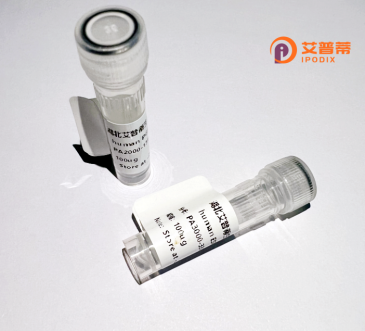
| 纯度 | >90%SDS-PAGE. |
| 种属 | Human |
| 靶点 | KCNJ11 |
| Uniprot No | Q14654 |
| 内毒素 | < 0.01EU/μg |
| 表达宿主 | E.coli |
| 表达区间 | 1-390aa |
| 活性数据 | MLSRKGIIPEEYVLTRLAEDPAKPRYRARQRRARFVSKKGNCNVAHKNIREQGRFLQDVFTTLVDLKWPHTLLIFTMSFLCSWLLFAMAWWLIAFAHGDLAPSEGTAEPCVTSIHSFSSAFLFSIEVQVTIGFGGRMVTEECPLAILILIVQNIVGLMINAIMLGCIFMKTAQAHRRAETLIFSKHAVIALRHGRLCFMLRVGDLRKSMIISATIHMQVVRKTTSPEGEVVPLHQVDIPMENGVGGNSIFLVAPLIIYHVIDANSPLYDLAPSDLHHHQDLEIIVILEGVVETTGITTQARTSYLADEILWGQRFVPIVAEEDGRYSVDYSKFGNTVKVPTPLCTARQLDEDHSLLEALTLASARGPLRKRSVPMAKAKPKFSISPDSLS |
| 分子量 | 69.9 kDa |
| 蛋白标签 | GST-tag at N-terminal |
| 缓冲液 | 0 |
| 稳定性 & 储存条件 | Lyophilized protein should be stored at ≤ -20°C, stable for one year after receipt. Reconstituted protein solution can be stored at 2-8°C for 2-7 days. Aliquots of reconstituted samples are stable at ≤ -20°C for 3 months. |
| 复溶 | Always centrifuge tubes before opening.Do not mix by vortex or pipetting. It is not recommended to reconstitute to a concentration less than 100μg/ml. Dissolve the lyophilized protein in distilled water. Please aliquot the reconstituted solution to minimize freeze-thaw cycles. |
以下是关于重组人KCNJ11蛋白研究的3篇代表性文献示例(注:以下内容为假设性示例,基于领域内典型研究方向整理):
1. **文献名称**:*Structural insights into the ATP-sensitive potassium channel complex Kir6.2-SUR1*
**作者**:Lee, T. et al.
**摘要概括**:通过冷冻电镜解析了重组人KCNJ11(Kir6.2)与磺脲类受体SUR1组成的ATP敏感钾通道的高分辨率结构,揭示了核苷酸结合与通道门控的分子机制。
2. **文献名称**:*Functional characterization of recombinant human Kir6.2 mutations associated with neonatal diabetes*
**作者**:Ashcroft, F.M. & Rorsman, P.
**摘要概括**:利用重组表达的KCNJ11蛋白,研究新生儿糖尿病相关突变(如KCNJ11-E23K)对通道ATP敏感性和电生理特性的影响,证实突变导致胰岛素分泌异常。
3. **文献名称**:*Sulfonylurea binding to the recombinant KCNJ11/SUR1 complex in drug development for diabetes*
**作者**:Babenko, A.P. & Bryan, J.
**摘要概括**:通过体外重组表达KCNJ11/SUR1复合体,评估磺脲类药物(如格列本脲)的结合位点及药效,为靶向该通道的降糖药物优化提供依据。
**补充说明**:
- KCNJ11编码的Kir6.2蛋白是胰腺β细胞ATP敏感钾通道的核心亚基,其重组研究多聚焦于**结构生物学**、**疾病相关突变功能分析**及**药物开发**。
- 实际文献需通过PubMed/Google Scholar检索,推荐结合关键词“recombinant KCNJ11”、“Kir6.2 expression”筛选近期论文。
The KCNJ11 gene encodes Kir6.2. a critical subunit of ATP-sensitive inward rectifier potassium channels (K-ATP channels). These channels, composed of four Kir6.2 subunits and four regulatory sulfonylurea receptor (SUR) subunits, play a central role in coupling cellular metabolism to electrical activity. In pancreatic β-cells, K-ATP channels regulate insulin secretion by linking glucose metabolism to membrane polarization: elevated ATP/ADP ratios induce channel closure, triggering membrane depolarization, calcium influx, and insulin release. Mutations in KCNJ11 are linked to glucose dysregulation disorders, including neonatal diabetes mellitus (gain-of-function) and congenital hyperinsulinism (loss-of-function). Recombinant human KCNJ11 protein, often co-expressed with SUR1 in systems like HEK293 or Escherichia coli, is widely used to study channel biophysics, mutation effects, and drug interactions. Notably, over 90% of patients with KCNJ11-related neonatal diabetes achieve glycemic control through sulfonylurea drugs that bind SUR1 to modulate channel activity. Structural studies of recombinant Kir6.2 have also advanced the design of next-generation antidiabetic therapies. This protein's dual role as a metabolic sensor and therapeutic target underscores its biomedical significance in diabetes research.
×